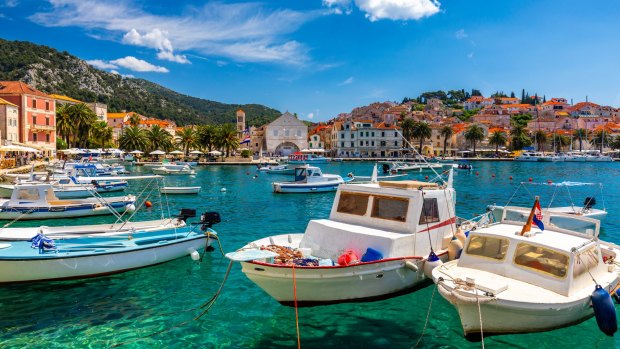By Brian Johnston
PIRAN, SLOVENIA
The splendid eastern Adriatic coast has always been about sea trade, making cruising an apt way to explore. Slovenia's petite coastline, backed by hills of olive trees and wedged between Italy and Croatia, brings the Adriatic's first pleasures on cruises sailing south from Venice. This region was part of the Venetian Empire for five centuries, and salt-trading centre Piran has very Venetian-looking architecture featuring winged lions and pretty Gothic facades. If you have time, seek out delightful Minorite Convent, whose courtyard often hosts outdoor concerts, and catch the sunset on the harbour-side promenades of this peninsular old town. See portoroz.si
TROGIR, CROATIA

Boats docked in the old Adriatic island town of Hvar, Croatia.Credit: Shutterstock
Sail into Croatian waters and your first port encounters might be photogenic Rovinj, or Pula for its superb first-century amphitheatre. Trogir further south was founded by the Greeks in the third century BC and has Roman remains, but the current town is medieval and sits on a well-defended islet just off modern mainland Trogir. Elaborate stonework comes emblazoned with coats-of-arms, and tiny churches lurk in intimate squares. The town is enlivened by guitar-strumming buskers, while shopkeepers sell lavender oil and delicate local lace. Good seafood restaurants might tempt you away from on-board dining with their peppered swordfish. See visittrogir.hr
SPLIT, CROATIA
Just 30 kilometres south of Trogir, the Croatian coast's largest city and busiest port has a fabulous old town embedded in the ruins of a vast Roman-era palace dating to 305AD, when the emperor Diocletian chose this coast for his retirement. It's all World Heritage listed but still vibrant with shops, gelato stores and eateries. Split's contemporary seaside promenades also make for a great stroll. The cruise terminal is a 10-minute walk, so it's worth returning in the evening for the town's buzzing atmosphere, gorgeous sunsets and local white wine. See visitsplit.com
HVAR, CROATIA
Along the southern Croatian coast, cruise ships abandon the mainland and navigate lavender-scented islands. Hvar is the highlight for the upmarket, jet-setting yachtie town of the same name, Croatia's answer to chic Saint-Tropez. The Renaissance gem features monasteries, chapels and shady alleys centred on a superb piazza paved in marble. You should hike to the fortress above for splendid views, though it's more de rigueur to haunt the fashion boutiques and trendy harbour-side bars. Some shore excursions take you beyond town to the island's vineyards for wine tasting, or to lavender farms to meet with producers. See tzhvar.novena.hr
KORČULA, CROATIA
Korčula island, birthplace of Marco Polo, is somewhat unfairly called the poor man's Hvar. It isn't as sleek, but its walled town is lovely, and chock full of cafés and gelato shops. Restaurants dish up octopus salad and the island's pungent white wine. Hilly, medieval streets are punctuated with defensive towers and cluttered with saint statues. The town also has some impressive surprises such as the Abbey Treasury, which is full of Titians and Tintorettos. Outside town, the undulating landscape is scattered with olive groves and fruit orchards, and indented by tranquil bays in which seahorses float. See visitkorcula.eu
KOTOR, MONTENEGRO
The great sunken valley that pierces 30 kilometres into the coast towards Kotor is the Mediterranean equivalent of a fiord, framed in cliffs. It's a dramatic sail, so make sure you're up on deck. Cruise ships dock almost beneath the fortified walls of Kotor's old town, which has Roman origins but is World Heritage listed for its mostly medieval ensemble of architecture. It's like a mini Dubrovnik, though less crowded. Shake out the sea legs with a walk along the city walls to St John's Fortress, which takes about an hour and a half return. See touristiko.me
Brian Johnston travelled courtesy of Visit Croatia and at his own expense.
Sign up for the Traveller Deals newsletter
Get exclusive travel deals delivered straight to your inbox. Sign up now.